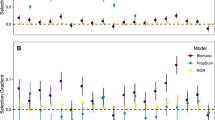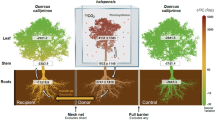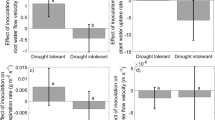Abstract
Alien plants represent a potential threat to environment and society. Understanding the process of alien plants naturalization is therefore of primary importance. In alien plants, successful establishment can be constrained by the absence of suitable fungal partners. Here, we used 42 independent datasets of ectomycorrhizal fungal (EcMF) communities associated with alien Pinaceae and Eucalyptus spp., as the most commonly introduced tree species worldwide, to explore the strategies these plant groups utilize to establish symbioses with EcMF in the areas of introduction. We have also determined the differences in composition of EcMF communities associated with alien ectomycorrhizal plants in different regions. While alien Pinaceae introduced to new regions rely upon association with co-introduced EcMF, alien Eucalyptus often form novel interactions with EcMF species native to the region where the plant was introduced. The region of origin primarily determines species composition of EcMF communities associated with alien Pinaceae in new areas, which may largely affect invasion potential of the alien plants. Our study shows that alien ectomycorrhizal plants largely differ in their ability to interact with co-introduced and native ectomycorrhizal fungi in sites of introduction, which may potentially affect their invasive potential.
Similar content being viewed by others
Log in or create a free account to read this content
Gain free access to this article, as well as selected content from this journal and more on nature.com
or
References
Davis M. Invasion Biology, 1st ed. Oxford: Oxford University Press; 2009.
Vilà M, Bartomeus I, Dietzsch AC, Petanidou T, Steffan-Dewenter I, Stout JC, et al. Invasive plant integration into native plant–pollinator networks across Europe. Proc R Soc B Biol Sci. 2009;276:3887–93.
Blackburn TM, Essl F, Evans T, Hulme PE, Jeschke JM, Kühn I, et al. A unified classification of alien species based on the magnitude of their environmental impacts. PLoS Biol. 2014;12:e1001850.
Seebens H, Blackburn TM, Dyer EE, Genovesi P, Hulme PE, Jeschke JM, et al. No saturation in the accumulation of alien species worldwide. Nat Commun. 2017;8:1–9.
Vilà M, Basnou C, Pyšek P, Josefsson M, Genovesi P, Gollasch S, et al. How well do we understand the impacts of alien species on ecosystem services? A pan-European, cross-taxa assessment. Front Ecol Environ. 2010;8:135–44.
Bacher S, Blackburn TM, Essl F, Genovesi P, Heikkilä J, Jeschke JM, et al. Socio-economic impact classification of alien taxa (SEICAT). Methods Ecol Evol. 2018;9:159–68.
Richardson DM, Allsopp N, D’Antonio CM, Milton SJ, Rejmánek M. Plant invasions—the role of mutualism. Biol Rev. 2000;75:65–93.
Mitchell CE, Agrawal AA, Bever JD, Gilbert GS, Hufbauer RA, Klironomos JN, et al. Biotic interactions and plant invasions. Ecol Lett. 2006;9:726–40.
Catford JA, Smith AL, Wragg PD, Clark AT, Kosmala M, Cavender-Bares J, et al. Traits linked with species invasiveness and community invasibility vary with time, stage and indicator of invasion in a long-term grassland experiment. Ecol Lett. 2019;22:593–604.
Pyšek P, Manceur AM, Alba C, McGregor KF, Pergl J, Štajerová K, et al. Naturalization of central European plants in North America: Species traits, habitats, propagule pressure, residence time. Ecology. 2015;96:762–74.
Keane RM, Crawley MJ. Exotic plant invasions and the enemy release hypothesis. Trends Ecol Evol. 2002;17:164–70.
Nuñez MA, Dickie IA. Invasive belowground mutualists of woody plants. Biol Invasions. 2014;16:645–61.
Nuñez MA, Horton TR, Simberloff D. Lack of belowground mutualisms hinders Pinaceae invasions. Ecology. 2009;90:2352–5359.
Rundel PW, Dickie IA, Richardson DM. Tree invasions into treeless areas: mechanisms and ecosystem processes. Biol Invasions. 2014;16:663–75.
Delavaux CS, Weigelt P, Dawson W, Duchicela J, Essl F, van Kleunen M, et al. Mycorrhizal fungi influence global plant biogeography. Nat Ecol Evol. 2019;3:424–9.
Policelli N, Bruns TD, Vilgalys R, Nuñez MA. Suilloid fungi as global drivers of pine invasions. N. Phytol. 2019;222:714–25.
Smith SE, Read DJ. Mycorrhizal symbiosis. 3rd ed. New York, USA: Academic Press; 2008.
Dickie IA, Bolstridge N, Cooper JA, Peltzer DA. Co-invasion by Pinus and its mycorrhizal fungi. N. Phytol. 2010;187:475–84.
Dickie IA, Bufford JL, Cobb RC, Desprez-Loustau ML, Grelet G, Hulme PE, et al. The emerging science of linked plant–fungal invasions. N. Phytol. 2017;215:1314–32.
Marx DH. The practical significance of ectomycorrhizae in forest establishment. Ecophysiology of Ectomycorrhizae of Forest Trees. Stockholm, Sweden: Marcus Wallenberg Foundation; 1991. pp. 54–90.
Bogar LM, Dickie IA, Kennedy PG. Testing the co-invasion hypothesis: ectomycorrhizal fungal communities on Alnus glutinosa and Salix fragilis in New Zealand. Divers Distrib. 2015;21:268–78.
Díez J. Invasion biology of Australian ectomycorrhizal fungi introduced with eucalypt plantations into the Iberian Peninsula. Biol Invasions. 2005;7:3–15.
Séne S, Avril R, Chaintreuil C, Geoffroy A, Ndiaye C, Diédhiou AG, et al. Ectomycorrhizal fungal communities of Coccoloba uvifera (L.) L. mature trees and seedlings in the neotropical coastal forests of Guadeloupe (Lesser Antilles). Mycorrhiza. 2015;25:547–59.
Tedersoo L, Suvi T, Beaver K, Kõljalg U. Ectomycorrhizal fungi of the Seychelles: diversity patterns and host shifts from the native Vateriopsis seychellarum (Dipterocarpaceae) and Intsia bijuga (Caesalpiniaceae) to the introduced Eucalyptus robusta (Myrtaceae), but not Pinus caribea (Pinaceae). N. Phytol. 2007;175:321–33.
Sulzbacher MA, Grebenc T, Bevilacqua CB, Steffen RB, Coelho G, Silveira AO, et al. Co-invasion of ectomycorrhizal fungi in the Brazilian Pampa biome. Appl Soil Ecol. 2018;130:194–201.
Bahram M, Kõljalg U, Courty PE, Diédhiou AG, Kjøller R, Põlme S, et al. The distance decay of similarity in communities of ectomycorrhizal fungi in different ecosystems and scales. J Ecol. 2013;101:1335–44.
Thoen E, Aas AB, Vik U, Brysting AK, Skrede I, Carlsen T, et al. A single ectomycorrhizal plant root system includes a diverse and spatially structured fungal community. Mycorrhiza. 2019;29:167–80.
Hayward J, Horton TR, Pauchard A, Nuñez MA. A single ectomycorrhizal fungal species can enable a Pinus invasion. Ecology. 2015;96:1438–44.
Séne S, Selosse M-A, Forget M, Lambourdière J, Cissé K, Diédhiou AG, et al. A pantropically introduced tree is followed by specific ectomycorrhizal symbionts due to pseudo-vertical transmission. ISME J. 2018;12:1806–16.
Dickie IA, Nuñez MA, Pringle A, Lebel T, Tourtellot SG, Johnston PR. Towards management of invasive ectomycorrhizal fungi. Biol Invasions. 2016;18:3383–95.
Richardson DM. Forestry trees as invasive aliens. Conserv Biol. 1998;12:18–26.
Richardson DM, Pyšek P, Rejmánek M, Barbour MG, Panetta FD, West CJ. Naturalization and invasion of alien plants: concepts and definitions. Divers Distrib. 2000;6:93–107.
Richardson DM, Rejmánek M. Conifers as invasive aliens: a global survey and predictive framework. Divers Distrib. 2004;10:321–31.
Tedersoo L. Global biogeography and invasions of ectomycorrhizal plants: Past, present and future. Biogeography of Mycorrhizal Symbiosis. Springer International Publishing; Cham, Switzerland, 2017. pp 469–531.
Brundrett MC, Tedersoo L. Evolutionary history of mycorrhizal symbioses and global host plant diversity. N. Phytol. 2018;220:1108–15.
Traveset A, Richardson DM. Mutualistic interactions and biological invasions. Annu Rev Ecol Evol Syst. 2014;45:89–113.
Simberloff D, Nuñez MA, Ledgard NJ, Pauchard A, Richardson DM, Sarasola M, et al. Spread and impact of introduced conifers in South America: Lessons from other southern hemisphere regions. Austral Ecol. 2010;35:489–504.
Rejmánek M, Richardson DM. Eucalypts. In: Simberloff D, Rejmánek M, (eds). Encyclopedia of Biological Invasions. 1st ed. Berkeley and Los Angeles: University of California Press; 2011. p. 792.
Brundrett MC, Bougher NL, Dell B, Grove T, Malajczuk N. Working with mycorrhizas in forestry and agriculture. Canberra, Australia: Australian Centre for International Agricultural Research; 1996.
Rejmánek M, Richardson DM. Trees and shrubs as invasive alien species—2013 update of the global database. Divers Distrib. 2013;19:1093–4.
Richardson DM, Williams PA, Hobbs RJ. Pine invasions in the Southern Hemisphere: determinants of spread and invadability. J Biogeogr. 1994;21:511–27.
Richardson DM, Hui C, Nuñez MA, Pauchard A. Tree invasions: patterns, processes, challenges and opportunities. Biol Invasions. 2014;16:473–81.
Gordon DR, Flory SL, Cooper AL, Morris SK. Assessing the invasion risk of eucalyptus in the United States using the Australian weed risk assessment. Int J Res. 2012;2012:1–7.
Calviño-Cancela M, van Etten EJB. Invasive potential of Eucalyptus globulus and Pinus radiata into native eucalypt forests in Western Australia. Ecol Manag. 2018;424:246–58.
Tererai F, Gaertner M, Jacobs SM, Richardson DM. Eucalyptus invasions in riparian forests: effects on native vegetation community diversity, stand structure and composition. Ecol Manag. 2013;297:84–93.
Richardson DM, Macdonald IAW, Forsyth GG. Reductions in plant species richness under stands of alien trees and shrubs in the fynbos biome. South Afr J. 1989;149:1–8.
Schoch CL, Seifert KA, Huhndorf S, Robert V, Spouge JL, Levesque CA, et al. Nuclear ribosomal internal transcribed spacer (ITS) region as a universal DNA barcode marker for Fungi. Proc Natl Acad Sci. 2012;109:6241–6.
Abarenkov K, Nilsson RH, Larsson KH, Alexander IJ, Eberhardt U, Erland S, et al. The UNITE database for molecular identification of fungi-recent updates and future perspectives. N. Phytol. 2010;186:281–5.
Kõljalg U, Nilsson RH, Abarenkov K, Tedersoo L, Taylor AFS, Bahram M. Towards a unified paradigm for sequence-based identification of fungi. Mol Ecol. 2013;22:5271–7.
Altschul SF, Gish W, Miller W, Myers EW, Lipman DJ. Basic local alignment search tool. J Mol Biol. 1990;215:403–10.
Tedersoo L, May TW, Smith ME. Ectomycorrhizal lifestyle in fungi: global diversity, distribution, and evolution of phylogenetic lineages. Mycorrhiza. 2010;20:217–63.
Tedersoo L, Smith ME. Ectomycorrhizal fungal lineages: detection of four new groups and notes on consistent recognition of ectomycorrhizal taxa in high-throughput sequencing studies. In: Tedersoo L (ed.). Biogeography of Mycorrhizal Symbiosis. Springer International Publishing AG; Cham, Switzerland, 2017. pp 125–42.
Větrovský T, Kohout P, Kopecký M, Machač A, Man M, Bahnmann BD, et al. A meta-analysis of global fungal distribution reveals climate-driven patterns. Nat Commun. 2019;10:1–9.
Vlk L, Tedersoo L, Antl T, Větrovský T, Abarenkov K, Pergl J, et al. Early successional ectomycorrhizal fungi are more likely to naturalize outside their native range than other ectomycorrhizal fungi. New Phytol. 2020.
Morrone JJ. Biogeographical regionalisation of the world: a reappraisal. Aust Syst Bot. 2015;28:81–90.
Oksanen J, Blanchet FG, Kindt R, Legendre P, Minchin PR, O’Hara RB, et al. Vegan: community ecology package. R package version 2.0-10. 2012.
Goslee SC, Urban DL. The ecodist package for dissimilarity-based analysis of ecological data. J Stat Softw. 2007;22:1–19.
Anderson MJ, Crist TO, Chase JM, Vellend M, Inouye BD, Freestone AL, et al. Navigating the multiple meanings of β diversity: a roadmap for the practicing ecologist. Ecol Lett. 2011;14:19–28.
Crawley MJ. The R Book. Chichester: Wiley Publishing; 2007.
Řehák J, Řeháková B. Analýza kategorizovaných dat v sociologii [Analysis of categorical data in sociology]. Prague: Academia; 1986.
Vinogradova Y, Pergl J, Essl F, Hejda M, van Kleunen M, Pyšek P. Invasive alien plants of Russia: insights from regional inventories. Biol Invasions. 2018;20:1931–43.
R Development Core Team. R: A language and environment for statistical computing. Vienna, Austria. Vienna, Austria: R Foundation for Statistical Computing; 2019.
Moyano J, Rodriguez‐Cabal MA, Nuñez MA. Highly invasive tree species are more dependent on mutualisms. Ecology. 2020;101:e02997.
Richardson DM, Rejmánek M. Trees and shrubs as invasive alien species—a global review. Divers Distrib. 2011;17:788–809.
Alpert P. The advantages and disadvantages of being introduced. Biol Invasions. 2006;8:1523–34.
Catford JA, Jansson R, Nilsson C. Reducing redundancy in invasion ecology by integrating hypotheses into a single theoretical framework. Divers Distrib. 2009;15:22–40.
Molina R, Trappe JM. Biology of the ectomycorrhizal genus Rhizopogon I: host associations, host-specificity and pure culture syntheses. N. Phytol. 1994;126:653–75.
Bruns TD, Bidartondo MI, Taylor DL. Host specificity in ectomycorrhizal communities: What do the exceptions tell us? Integr Comp Biol. 2002;42:352–9.
Nguyen NH, Vellinga EC, Bruns TD, Kennedy PG. Phylogenetic assessment of global Suillus ITS sequences supports morphologically defined species and reveals synonymous and undescribed taxa. Mycologia. 2016;108:1216–28.
Malajczuk N, Molina R, Trappe JM. Ectomycorrhiza formation in Eucalyptus. I. Pure culture synthesis, host specificity and mycorrhizal compatibility with Pinus radiata. N. Phytol. 1982;91:467–82.
Mortenson SG, Mack RN. The fate of alien conifers in long-term plantings in the USA. Divers Distrib. 2006;12:456–66.
Reichard SH. Assessing the potential of invasiveness in woody plants introduced in North America. Seattle: University of Washington; 1994.
Hynson NA, Merckx VSFT, Perry BA, Treseder KK. Identities and distributions of the co-invading ectomycorrhizal fungal symbionts of exotic pines in the Hawaiian Islands. Biol Invasions. 2013;15:2373–85.
Hawley GL, Taylor AFS, Dames JF. Ectomycorrhizas in association with Pinus patula in Sabie, South Africa. S Afr J Sci. 2008;104:273–83.
Nuñez MA, Hayward J, Horton TR, Amico GC, Dimarco RD, Barrios-Garcia MN, et al. Exotic mammals disperse exotic fungi that promote invasion by exotic trees. PLoS One. 2013;8:1–6.
Hayward J, Horton TR, Nuñez MA. Ectomycorrhizal fungal communities coinvading with Pinaceae host plants in Argentina: Gringos bajo el bosque. N. Phytol. 2015;208:497–506.
Tedersoo L, Bahram M, Jairus T, Bechem E, Chinoya S, Mpumba R, et al. Spatial structure and the effects of host and soil environments on communities of ectomycorrhizal fungi in wooded savannas and rain forests of Continental Africa and Madagascar. Mol Ecol. 2011;20:3071–80.
Walbert K, Ramsfield TD, Ridgway HJ, Jones EE. Ectomycorrhizal species associated with Pinus radiata in New Zealand including novel associations determined by molecular analysis. Mycorrhiza. 2010;20:209–15.
Murat C, Díez J, Luis P, Delaruelle C, Dupré C, Chevalier G, et al. Polymorphism at the ribosomal DNA ITS and its relation to postglacial re-colonization routes of the Perigord truffle Tuber melanosporum. N. Phytol. 2004;164:401–11.
Põlme S, Bahram M, Yamanaka T, Nara K, Dai YC, Grebenc T, et al. Biogeography of ectomycorrhizal fungi associated with alders (Alnus spp.) in relation to biotic and abiotic variables at the global scale. N. Phytol. 2013;198:1239–49.
Setaro SD, Kron K. Neotropical and north american vaccinioideae (ericaceae) share their mycorrhizal sebacinales-an indication for concerted migration? PLoS Curr. 2011;3:RRN1227.
Kohout P, Sýkorová Z, Bahram M, Hadincová V, Albrechtová J, Tedersoo L, et al. Ericaceous dwarf shrubs affect ectomycorrhizal fungal community of the invasive Pinus strobus and native Pinus sylvestris in a pot experiment. Mycorrhiza. 2011;21:403–12.
Pietras M, Kolanowska M. Predicted potential occurrence of the North American false truffle Rhizopogon salebrosus in Europe. Fungal Ecol. 2019;39:225–30.
Koske RE, Gemma JN, Flynn T. Mycorrhizae in hawaiian angiosperms: a survey with implications for the origin of the native flora. Am J Bot. 1992;79:843–52.
Lososová Z, de Bello F, Chytrý M, Kühn I, Pyšek P, Sádlo J, et al. Alien plants invade more phylogenetically clustered community types and cause even stronger clustering. Glob Ecol Biogeogr. 2015;24:786–94.
Divíšek J, Chytrý M, Beckage B, Gotelli NJ, Lososová Z, Pyšek P, et al. Similarity of introduced plant species to native ones facilitates naturalization, but differences enhance invasion success. Nat Commun. 2018;9:1–10.
Elton CS. The ecology of invasions by animals and plants. London: Methuen; 1958.
Obase K, Douhan GW, Matsuda Y, Smith ME. Progress and challenges in understanding the biology, diversity, and biogeography of Cenococcum geophilum. Biogeography of Mycorrhizal Symbiosis. Springer International Publishing; Cham, Switzerland, 2017. pp 299–317.
Chapela IH, Osher LJ, Horton TR, Henn MR. Ectomycorrhizal fungi introduced with exotic pine plantations induce soil carbon depletion. Soil Biol Biochem. 2001;33:1733–40.
Read DJ, Perez-Moreno J. Mycorrhizas and nutrient cycling in ecosystems—a journey towards relevance? N. Phytol. 2003;157:475–92.
Clemmensen KE, Finlay RD, Dahlberg A, Stenlid J, Wardle DA, Lindahl BD. Carbon sequestration is related to mycorrhizal fungal community shifts during long-term succession in boreal forests. N. Phytol. 2014;205:1525–36.
Jairus T, Mpumba R, Chinoya S, Tedersoo L. Invasion potential and host shifts of Australian and African ectomycorrhizal fungi in mixed eucalypt plantations. N. Phytol. 2011;192:179–87.
Buyck B. The edible mushrooms of Madagascar: an evolving enigma. Econ Bot. 2008;62:509–20.
Pennington HG, Bidartondo MI, Barsoum N. A few exotic mycorrhizal fungi dominate eucalypts planted in England. Fungal Ecol. 2011;4:299–302.
Kjøller R. Disproportionate abundance between ectomycorrhizal root tips and their associated mycelia. FEMS Microbiol Ecol. 2006;58:214–24.
Johnson NC, Wilson GWT, Bowker MA, Wilson JA, Miller RM. Resource limitation is a driver of local adaptation in mycorrhizal symbioses. Proc Natl Acad Sci. 2010;107:2093–8.
Bashir H, Khalid AN. Morpho-anatomical and molecular characterisation of ectomycorrhizae associated with Eucalyptus species growing in different areas of the Punjab Province, Pakistan. Aust J Bot. 2014;62:689–97.
Tedersoo L, Bahram M, Põlme S, Kõljalg U, Yorou NS, Wijesundera R, et al. Global diversity and geography of soil fungi. Science. 2014;346:1256688.
Stevens PF. Angiosperm Phylogeny Website. Version 14, July 2017 [and more or less continuously updated since]. http://www.mobot.org/MOBOT/research/APweb/.
Acknowledgements
The study was supported by the grant Biotic threats to monuments of garden art: algae, cyanobacteria, and invasive plants (DG16P02M041; NAKI II of the Ministry of Culture of the Czech Republic), and by Czech Science Foundation projects 18-26191S and EXPRO 19-28807X.
Author information
Authors and Affiliations
Corresponding author
Ethics declarations
Conflict of interest
The authors declare that they have no conflict of interest.
Additional information
Publisher’s note Springer Nature remains neutral with regard to jurisdictional claims in published maps and institutional affiliations.
Supplementary information
Rights and permissions
About this article
Cite this article
Vlk, L., Tedersoo, L., Antl, T. et al. Alien ectomycorrhizal plants differ in their ability to interact with co-introduced and native ectomycorrhizal fungi in novel sites. ISME J 14, 2336–2346 (2020). https://doi.org/10.1038/s41396-020-0692-5
Received:
Revised:
Accepted:
Published:
Issue date:
DOI: https://doi.org/10.1038/s41396-020-0692-5
This article is cited by
-
Mycelial communities associated with Ostrya carpinifolia, Quercus pubescens and Pinus nigra in a patchy Sub-Mediterranean Karst woodland
Mycorrhiza (2025)
-
The impact of land use change on mycorrhizal fungi and their associations with rodents: insights from a temperate forest in Mexico
Mycorrhiza (2025)
-
Palmitoleic acid as a coordinating molecule between the invasive pinewood nematode and its newly associated fungi
The ISME Journal (2023)
-
Pine invasion drives loss of soil fungal diversity
Biological Invasions (2022)
-
Rhizopogon confusus sp. nov., a correct name for a fungus previously recorded in Central Europe as the North American Rhizopogon salebrosus
Mycological Progress (2022)



